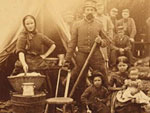At a Glance
Description
Children’s Voices from the Civil War

Textbooks, which feature the passive voice and condensed versions of momentous events, rarely capture the passion and drama of the past. By supplementing the textbook with documents that show how real-life children experienced historical events, the teacher can engage students' interests and can also offer multiple perspectives on historical events.
As an example of this approach, consider children's experiences during the Civil War. Although Joy Hakim's excellent textbook A History of US (volume six, War, Terrible War), touches on how the war affected children's lives, students can gain a much deeper understanding through analyzing additional primary sources. Documents such as period photos and excerpts from letters help students reconstruct what children experienced during the Civil War.
The destructive swath of "total war" drew children into its path as they witnessed violent death, looting and burning of their homes and farms, and occupation by the enemy. Boys as young as 13 enlisted as drummer boys, and while official recruitment policies required that a soldier be at least 18, many younger boys conveniently added a few years to their age or received permission from their fathers to enlist. Young girls were pressed into service as nurses when their farms and villages became battlefields.
After reading a section of the textbook, students analyze primary sources showing how children their age experienced the events described in the textbook. In this lesson, students examine excerpts from letters written by teenagers who witnessed or participated in Civil War battles, and they analyze period photographs to consider the extent and ramifications of children's involvement.
Teachers can adapt this approach to other historical topics by supplementing with the appropriate primary sources.
- To gain background knowledge, students read Chapter 16 of War, Terrible War, "The Soldiers.” Ask students to consider the following questions as they read.
- How did adolescent boys experience the war?
- How did adolescent girls experience the war?
- As you discuss the chapter with students, help them understand the mixture of excitement, optimism, boredom, homesickness, and terror that many young soldiers describe. Students may note that the chapter does not discuss how adolescent girls experienced the war.
- Assign students to teams or pairs. Distribute copies or display the photograph, "A Soldier and His Family." Explain to students that this photo was taken early in the war (1862) in the camp of the 31st Pennsylvania Infantry near Washington, DC. Ask students to speculate and discuss with their teammates the following questions.
- As a child, what do you think it would be like to live in a Civil War army camp? What responsibilities might the young girl pictured have?
- What does the photograph tell you about living in such a camp? What details in the photo support your impressions?
- Distribute the sheet "Children’s Voices from the Civil War" to student pairs or teams. Students discuss the quotes with teammates, and answer the following questions.
- How were boys' and girls' experiences of the war similar? Different?
- How did enslaved children view and experience the war?
- How did the war change the lives of the children being studied?
- What character qualities did these youths demonstrate in their response to war?
- How does it change your perspective to read the quotes from the boys and girls?
Comparing the textbook with additional primary source documents expands students' knowledge, breathes life into the text, and introduces the voices of those left out of the text—in this case, girls. While women did not officially serve as soldiers, some accompanied their husband or fathers to army camps or were pressed into service as nurses when battles raged near their homes. Supplementing the text with voices of young soldiers gives students a broader picture of how boys self-reported their reasons for enlisting and their experiences.
For more information
The photo, "A Soldier and His Family," is available on the Library of Congress website.
Hakim, Joy. A History of US. Vol. 6, War, Terrible War. New York: Oxford University Press, 2003.
Student handout, Children's Voices from the Civil War.
